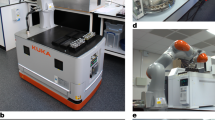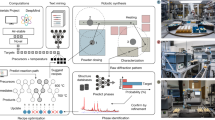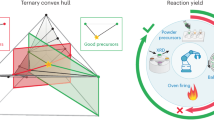Abstract
Living on Mars requires the ability to synthesize chemicals that are essential for survival, such as oxygen, from local Martian resources. However, this is a challenging task. Here we demonstrate a robotic artificial-intelligence chemist for automated synthesis and intelligent optimization of catalysts for the oxygen evolution reaction from Martian meteorites. The entire process, including Martian ore pretreatment, catalyst synthesis, characterization, testing and, most importantly, the search for the optimal catalyst formula, is performed without human intervention. Using a machine-learning model derived from both first-principles data and experimental measurements, this method automatically and rapidly identifies the optimal catalyst formula from more than three million possible compositions. The synthesized catalyst operates at a current density of 10 mA cm−2 for over 550,000 s of operation with an overpotential of 445.1 mV, demonstrating the feasibility of the artificial-intelligence chemist in the automated synthesis of chemicals and materials for Mars exploration.

This is a preview of subscription content, access via your institution
Access options
Subscribe to this journal
Receive 12 digital issues and online access to articles
$119.00 per year
only $9.92 per issue
Buy this article
- Purchase on Springer Link
- Instant access to full article PDF
Prices may be subject to local taxes which are calculated during checkout




Similar content being viewed by others
Data availability
The data that support the findings of this study are available in the paper, its Supplementary Information and Supplementary Video 1.
Code availability
The code used for training an NN model for OER prediction with theoretical data and robot-driven experimental data is available on GitHub at https://github.com/Lulu971231/code-for-Oxygen-Producing-Catalysts-from-Martian-Meteorites.
References
Gayen, P., Sankarasubramanian, S. & Ramani, V. K. Fuel and oxygen harvesting from Martian regolithic brine. Proc. Natl Acad. Sci. USA 117, 31685–31689 (2020).
Hoffman, J. A. et al. Mars Oxygen ISRU Experiment (MOXIE)—preparing for human Mars exploration. Sci. Adv. 8, eabp8636 (2022).
Wade, J., Dyck, B., Palin, R. M., Moore, J. D. P. & Smye, A. J. The divergent fates of primitive hydrospheric water on Earth and Mars. Nature 552, 391–394 (2017).
Orosei, R. et al. Radar evidence of subglacial liquid water on Mars. Science 361, 490–493 (2018).
Kruyer, N. S., Realff, M. J., Sun, W., Genzale, C. L. & Peralta-Yahya, P. Designing the bioproduction of Martian rocket propellant via a biotechnology-enabled in situ resource utilization strategy. Nat. Commun. 12, 6166 (2021).
Yao, Y. et al. Extraterrestrial photosynthesis by Chang’E-5 lunar soil. Joule 6, 1008–1014 (2022).
Burger, B. et al. A mobile robotic chemist. Nature 583, 237–241 (2020).
Rohrbach, S. et al. Digitization and validation of a chemical synthesis literature database in the ChemPU. Science 377, 172–180 (2022).
Zhu, Q. et al. An all-round AI-chemist with a scientific mind. Natl Sci. Rev. 9, nwac190 (2022).
Pyzer-Knapp, E. O., Chen, L., Day, G. M. & Cooper, A. I. Accelerating computational discovery of porous solids through improved navigation of energy-structure-function maps. Sci. Adv. 7, eabi4763 (2022).
Butler, K. T., Davies, D. W., Cartwright, H., Isayev, O. & Walsh, A. Machine learning for molecular and materials science. Nature 559, 547–555 (2018).
Sanchez-Lengeling, B. & Aspuru-Guzik, A. Inverse molecular design using machine learning: generative models for matter engineering. Science 361, 360–365 (2018).
Bai, L., Hsu, C.-S., Alexander, D. T. L., Chen, H. M. & Hu, X. Double-atom catalysts as a molecular platform for heterogeneous oxygen evolution electrocatalysis. Nat. Energy 6, 1054–1066 (2021).
Lin, C. et al. In-situ reconstructed Ru atom array on α-MnO2 with enhanced performance for acidic water oxidation. Nat. Catal. 4, 1012–1023 (2021).
Xu, H., Cheng, D., Cao, D. & Zeng, X. C. A universal principle for a rational design of single-atom electrocatalysts. Nat. Catal. 1, 339–348 (2018).
Craig, M. J. et al. Universal scaling relations for the rational design of molecular water oxidation catalysts with near-zero overpotential. Nat. Commun. 10, 4993 (2019).
Tao, L. et al. Charge transfer modulated activity of carbon-based electrocatalysts. Adv. Energy Mater. 10, 1901227 (2020).
Walter, M. G. et al. Solar water splitting cells. Chem. Rev. 110, 6446–6473 (2010).
Appelbaum, J. & Flood, D. J. Solar radiation on Mars. Sol. Energy 45, 353–363 (1990).
McCrory, C. C. L., Jung, S., Peters, J. C. & Jaramillo, T. F. Benchmarking heterogeneous electrocatalysts for the oxygen evolution reaction. J. Am. Chem. Soc. 135, 16977–16987 (2013).
Hecht, M. H. et al. Detection of perchlorate and the soluble chemistry of Martian soil at the Phoenix lander site. Science 325, 64–67 (2009).
Cull, S. C. et al. Concentrated perchlorate at the Mars Phoenix landing site: evidence for thin film liquid water on Mars. Geophys. Res. Lett. 37, L22203 (2010).
Schröder, C. et al. Meteorites on Mars observed with the Mars exploration rovers. J. Geophys. Res. 113, E06S22 (2008).
Ashley, J. CosmoELEMENTS: the study of exogenic rocks on Mars—an evolving subdiscipline in meteoritics. Elements 11, 10–11 (2015).
Jensen, C. M. & Lee, D. W. Dry-ice bath based on ethylene glycol mixtures. J. Chem. Educ. 77, 629 (2000).
Abraham, M. J. et al. GROMACS: high performance molecular simulations through multi-level parallelism from laptops to supercomputers. SoftwareX 1–2, 19–25 (2015).
Mayo, S. L., Olafson, B. D. & Goddard, W. A. DREIDING: a generic force field for molecular simulations. J. Phys. Chem. 94, 8897–8909 (1990).
Boyd, P. G., Moosavi, S. M., Witman, M. & Smit, B. Force-field prediction of materials properties in metal-organic frameworks. J. Phys. Chem. Lett. 8, 357–363 (2017).
Nosé, S. A unified formulation of the constant temperature molecular dynamics methods. J. Chem. Phys. 81, 511–519 (1984).
Hoover, W. G. Canonical dynamics: equilibrium phase-space distributions. Phys Rev A (Coll Park) 31, 1695–1697 (1985).
Plimpton, S. Fast parallel algorithms for short-range molecular dynamics. J. Comput. Phys. 117, 1–19 (1995).
Perdew, J. P., Burke, K. & Ernzerhof, M. Generalized gradient approximation made simple. Phys. Rev. Lett 77, 3865–3868 (1996).
Blöchl, P. E. Projector augmented-wave method. Phys. Rev. B 50, 17953–17979 (1994).
Kresse, G. & Furthmüller, J. Efficiency of ab-initio total energy calculations for metals and semiconductors using a plane-wave basis set. Comput. Mater. Sci. 6, 15–50 (1996).
Grimme, S., Ehrlich, S. & Goerigk, L. Effect of the damping function in dispersion corrected density functional theory. J Comput. Chem. 32, 1456–1465 (2011).
Maas, A. L., Hannun, A. Y. & Ng, A. Y. Rectifier nonlinearities improve neural network acoustic models. In Proc. 30th International Conference on Machine Learning (ICML) (eds Dasgupta, S. & McAllester, D.) 3 (ACM Press, 2013).
Abadi, M. et al. TensorFlow: a system for large-scale machine learning. In Proc 12th USENIX Conference on Operating Systems Design and Implementation (eds Keeton, K. & Roscoe, T.) 265–283 (USENIX Association, 2016).
Acknowledgements
Y.L. acknowledges funding support for this research from the Innovation Program for Quantum Science and Technology (Grant 2021ZD0303303). J.J. gratefully acknowledges financial support by the National Natural Science Foundation of China (Grants 22025304, 22033007) and the CAS Project for Young Scientists in Basic Research (Grant YSBR-005). Q.Z. gratefully acknowledges the financial support of the National Natural Science Foundation of China (Grant 22103076) and Anhui Provincial Natural Science Foundation (Grant 2108085QB63). We also gratefully acknowledge the USTC Center for Micro- and Nanoscale Research and Fabrication for providing experimental resources and the USTC supercomputing centre for providing computational resources.
Author information
Authors and Affiliations
Contributions
These authors contributed equally: Q.Z., Y.H., D.Z., L.Z. Q.Z. planned and conducted the robotic experiments and collected and analysed the experiment data. Y.H., D.Z., L.Z. and H.L. performed theoretical simulations and ML training. L.G., R.Y., Z.S. and M.L. assisted with the spectroscopic characterization and data analysis. H.X., B.Z. and J.C. were responsible for writing test scripts. X.T. and Y.Z. contributed to the development of robotic operation module, robotic arm motion planning and force control. J.Z. and B.C. helped with the robot platform communication, SLAM, platform motion planning and navigation. T.S. planned robot movement and operation task management system. X.L. and S.C. managed the scheduling optimization of robot experimental tasks at various workstations. X.Z. developed the robotic visual localization algorithm. F.Z. and W.S. designed the entire robot system. G.Y. and W.Z. worked on non-standardized equipment development. S.W., G.Z. and H.Z. contributed to the original draft preparation. L.-L.L. and Z.Z. assisted in the design and execution of experiments under simulated Martian environments. J.J. and Y.L. conceptualized the study, developed the methodology and conducted the investigation and wrote, reviewed and edited the paper. All authors participated in discussions and revisions and provided comments on the paper.
Corresponding authors
Ethics declarations
Competing interests
The authors declare no competing interests.
Peer review
Peer review information
Nature Synthesis thanks Leroy Cronin, Zhigang Zou and the other, anonymous, reviewer(s) for their contribution to the peer review of this work. Primary Handling Editor: Peter Seavill, in collaboration with the Nature Synthesis team.
Additional information
Publisher’s note Springer Nature remains neutral with regard to jurisdictional claims in published maps and institutional affiliations.
Supplementary information
Supplementary Information
Experimental details, Supplementary Figs. 1–22, Note 1 and Tables 1–4.
Supplementary Video 1
This video showcases the capabilities of the AI chemist in synthesizing and optimizing oxygen-producing catalysts from Martian meteorites. The process involves automated analysis of Martian ore, catalyst synthesis, characterization, intelligent computing and OER performance testing, which highlights the integration of robotics and AI for complex materials design and manufacture under challenging circumstances.
Source data
Source Data Fig. 2
Source data for Fig. 2.
Source Data Fig. 3
Source data for Fig. 3.
Source Data Fig. 4
Source data for Fig. 4.
Rights and permissions
Springer Nature or its licensor (e.g. a society or other partner) holds exclusive rights to this article under a publishing agreement with the author(s) or other rightsholder(s); author self-archiving of the accepted manuscript version of this article is solely governed by the terms of such publishing agreement and applicable law.
About this article
Cite this article
Zhu, Q., Huang, Y., Zhou, D. et al. Automated synthesis of oxygen-producing catalysts from Martian meteorites by a robotic AI chemist. Nat. Synth 3, 319–328 (2024). https://doi.org/10.1038/s44160-023-00424-1
Received:
Accepted:
Published:
Issue Date:
DOI: https://doi.org/10.1038/s44160-023-00424-1
This article is cited by
-
Bringing digital synthesis to Mars
Nature Synthesis (2024)
-
This AI robot chemist could make oxygen on Mars
Nature (2023)



